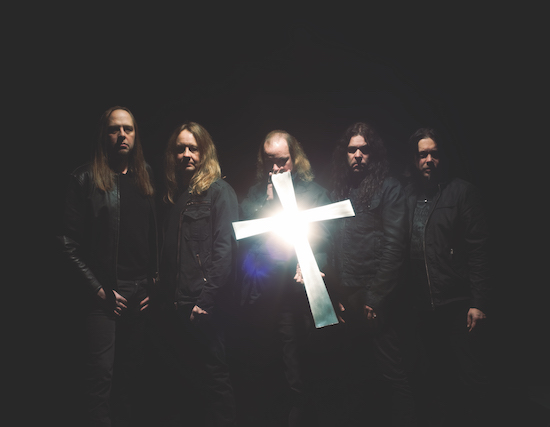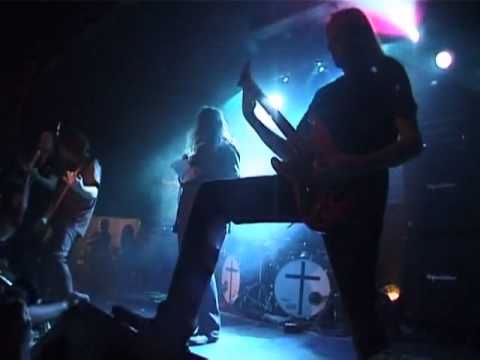On the morning of execution, prisoners were led in chains into the Press Yard of Newgate Prison. After the blacksmith removed their fetters, the Yeoman of the Halter tied a cord around their body and elbows, which left them with the ability to raise their arms together in prayer. The noose was placed around their neck, the free end coiled around their bodies. Put into open horse-drawn carts, the procession began towards Tyburn, two-and-a-half miles away.
Tyburn’s infamous “Triple Tree” gallows, established in 1571, was dragged into position by horses on the day of execution. The structure consisted of three uprights of 12-to-18 feet high joined at the top with beams in a triangular configuration to provide a triple gallows. Over twenty prisoners could be hanged simultaneously.
The jerking and struggling of the condemned as they slowly died became known as “dancing the Tyburn jig”. Relatives would expedite death by pulling on their legs. This infamous and foreboding site is marked today by a stone on the traffic island on the junction of Edgware Road, Marble Arch and Oxford Street in London.
Invoking “The hills of Tyburn, up where the gallows stand”, the site is commemorated in the song ‘At The Gallows End’ by Candlemass on their second album, Nightfall, released in 1987. Not only does it hold a candle to Iron Maiden’s awaiting-execution classic ‘Hallowed Be Thy Name’, it sends it up in flames.
The subject of the song laments his death: “Sunrise I greet you, the beauty of your light… In tears I see you, the last time it will be.” This opening is swept up in a shimmering lead guitar figure and summoned forth in crushing, crystal clear tones. Candlemass here create doom with grandeur, solemnity and a neoclassical outlook. It corresponds to the Thomas Cole painting ‘Old Age’ used as Nightfall’s cover: dark billowing clouds giving way to celestial light and the visitation of an angel.
Vocalist Messiah Marcolin sings for his life; overblown and operatic, on the cusp of absurd, but instead touching the profound. A consummate showman, his energetic performances belied his heavy frame – he was known to stow a reserve Big Mac in his monk’s costume to eat after shows.
The video for Nightfall track ‘Bewitched’ sees him assailing people on the street and leading a greasy heavy metal troupe in a sub-‘Thriller’ dance-along. It’s a hilarious, dirt cheap spectacle made more surreal by the fact one of the long-haired extras was Per Ohlin aka ‘Dead’, singer of Mayhem, who later infamously blew his brains out. The video was directed by Jonas Åkerlund (member of Bathory, later director of Lady Gaga’s ‘Telephone’ video), who recently recreated Dead’s own live performances for Metallica’s ‘ManUNkind’ video.
Although ‘At The Gallows End’ soon dives into a headlong chug Marcolin brings it up and out with majestic ease:
"Ring brother, ring for me
Ring the bells of hope and faith
Ring for my damnation
I am at the gallows end"
Facing and resolving oneself with death is the core theme of doom metal. In a world preoccupied with end time narratives, doom’s cultural currency is once again high and sees Candlemass joining a stellar bill for the closing night of this year’s Desertfest at the Camden Roundhouse.
Author Ian McEwan wrote a piece in 2008 responding to the growing panic over a world rife with religious fundamentalism: “Throughout recorded history people have mesmerized themselves with stories which predict the date and manner of our wholescale destruction, often rendered meaningful by ideas of divine punishment and ultimate redemption; the end of life on earth, the end or last days, end time, the apocalypse.’’ Doom metal seeks to make inevitable destruction somehow meaningful and possibly redemptive.
Doom subverts assumptions that all heavy metal music is inherently Satanic (or even Miltonic, pitting a charismatic Satan against a dull God) because it concerns itself lyrically with the Christian concept of Doom as Judgment Before God.
The narrator of ‘At The Gallows End’ uses his means of demise as an excuse to cast himself as a quasi-Christlike figure: “Behold the sight of my Golgotha/ The gallows enlightened by the moon”, then alternately as the fallen angel, devil’s progeny: “The Tempter has called me his son.” The aspiration to the divine and temptation by the diabolical provides most of the dramatic tension in the Candlemass catalogue. When I put that to long-time lead guitarist Lars Johansson he agreed that the lyrics are “sometimes a struggle between good or bad” but is conclusive about the band’s beliefs: “Candlemass is not a Christian band.”
The music emphatically reinforces the lyrics. As Marcolin hits the ‘end’ of the second chorus the song changes key for a powerful skyward guitar solo before it is dragged back into the dirt by a morose breakdown.
Another of the classic traditional doom acts is Maryland’s Trouble, who were marketed as a “white [Christian] metal” band (as opposed to “black” and satanic). Dave Grohl recorded ‘My Tortured Soul’ with vocalist Eric Wagner for his Probot project, stating that listening to Trouble’s Psalm 9 album was “like hearing Sgt. Pepper’s for the first time”.
Not that the “white” metal tag reflects any racial bias in doom. One of the underground favourites is Baltimore’s Iron Man, originally a Sabbath covers act which included two African-American members and were accordingly billed as, “Blacker than Black Sabbath”.
There’s a delicious turn in the road to redemption towards the finale of ‘At the Gallows End’, in the ultimate confession: “It’s no fun to burn in hell’s fire/ But I sure have enjoyed my life.” This is echoed in a new addition to the doomed prisoner canon: Inter Arma’s incredible song ‘The Paradise Gallows’ from the album of the same name released in 2016. A titanic collision of styles and one of the few bands that sound as good on record as Neurosis live, Inter Arma are appearing on the Saturday of Desertfest at the Camden Underworld.
An eleven-minute-plus epic that rises and falls like the thunderous sea, on ‘The Paradise Gallows’ vocalist Mike Paparo roars that “from these gallows paradise will scowl upon me”, but like Marcolin the conclusion sees him, if not unrepentant, then full of bravado: “Laughing all the way to my grave”.
Both ‘At The Gallows End’ and ‘The Paradise Gallows’ contain a historical truth. It was often observed at Tyburn that the prisoners made the most of being the stars of their own executions, whether in displays of courage, contrition or bitter humour.
Desertfest see Candlemass share the Sunday mainstage with Saint Vitus. This makes for a fascinating contrast, since Saint Vitus play a form of doom with roots in punk and hardcore, compared to the sheen and power of Candlemass’ sound, derived from heavy metal: “Maybe they are a little rawer (in a good way)”, says Johansson.
Saint Vitus emerged in California in the early Eighties, first fronted by Scott Reagers for their self-titled debut album (who will perform with them at Desertfest) and then Scott ‘Wino’ Weinrich, one of the most durable icons of the genre. Back in the day Saint Vitus would turn up and start to tear into their incredibly loud, slowed-down fuzzy wrecks of songs, clearly out of step with the faster punk contemporaries whose audiences hated them.
They were named after a Sicilian martyr, adopted by pagans in the late middle ages across Germany and the Slavic lands, and regarded as the patron saint of entertainment. The feast of Saint Vitus was accompanied by maniacal dancing before his statue which was dubbed the ‘St. Vitus Dance’, the name later given to the nervous disorder chorea and the title of a track from Black Sabbath’s Vol. 4 (1972).
Saint Vitus formed a partnership with the lightning-fast vitriol of Black Flag, led by Henry Rollins; the two groups toured together and the slowing down of Black Flag between their classic album Damaged (1981) and the second side of My War (1984) testifies to the influence of their tourmates (likewise Saint Vitus covered Black Flag songs).
The song ‘Born Too Late’ portrays the misery and sullen pride (even secret knowledge) of being out-of-sync with the trends of the subculture and a more general dislocation with wider society:
"Every time I’m on the street
People laugh and point at me
They talk about my length of hair
And the out of date clothes I wear
"They say my songs are much too slow
But they don’t know the things I know"
Like Saint Vitus, Candlemass has benefitted from more than one charismatic vocalist. Their first album Epicus Doomicus Metallicus (1986) was fronted by Johan Längquist, succeeded by Marcolin after he auditioned by singing its opening track ‘Solitude’ for band founder, chief songwriter and bassist Leif Edling down the telephone.
For a special twentieth anniversary performance by Candlemass in Kolingsborg, Sweden, they unveiled Solitude Aeturnus frontman Robert Lowe as their new vocalist. That night, ‘At The Gallows End’ was performed by Opeth’s Mikael Akerfeldt, replete with death metal growling on the verses. ‘Solitude’ closed the set, partly shared by Längquist and Lowe.
The subdued opening of ‘Solitude’ is a sigh for suicide or simply a plea to die in isolation (“I’m sitting here alone in darkness/ Waiting to be free”), then the deathly slow grind of the main riff reaches out like a claw dragging you into oblivion. With it, the vocal’s increased hysteria shows a mind deranged with anticipation of its own cessation, even to the point of grim triumph: “My lifeblood is exhausted!” For Johansson “it has a certain atmosphere in the sound itself cause this is 1986. Nothing had that sound at the time.”
The song’s title draws a direct line to the track of the same name from Sabbath’s third album and doom metal template Master Of Reality (1971). A moment of respite on that record, the softened melancholy and washed-out vibe of Sabbath’s ‘Solitude’ also invokes one of the genre’s long-running themes: an introspective shunning of the world, and an obviation of self in a weary sense of loss (“My name it means nothing/ My fortune is less/ My future is shrouded in dark wilderness”). It demonstrates that heaviness resides in the gravity of sentiment as much as powerful delivery.
On the limited edition of The King Of The Grey Islands, Robert Lowe’s debut with Candlemass from 2007, there are two bonus vocal sessions of him performing ‘Solitude’ and ‘At The Gallows End’. They are scratch recordings but his renditions are excellent, his rich mid-range punching through in a grittier way than Marcolin: the former song is full-blooded and positively strident, and the latter is no less a revelation, with its cleaner, early-morning light opening guitars bringing out more shades in the music. There’s an intimacy to the recordings which makes sense when Johansson confirms they were not originally intended for release.
Debate continues to rage about who is the ultimate Candlemass vocalist, with Marcolin and Längquist pitted like Tyson against Holyfield in their prime. For me, it’s Marcolin. Johansson thinks the different vocal styles come about because “all of them tried to cope with the doomyness [sic] in themselves I think. The music makes the style if you know what i mean.”
Now with Mats Levén on vocals, Candlemass released their Death Thy Lover EP last year. Although containing little revelation in terms of its sound, they still delight in giving a mesmerically heavy instrumental a title as puzzling as ‘The Goose’.
Having sold millions of albums worldwide, theirs is a legacy carved into gothic stone. Candlemass on form is a magnificent thing, their epic doom metal both grand and sometimes very sinister. Both ridiculous and resplendent, their music portrays the world in an unknowable, terrible light that compels listeners to examine the inward places of the soul. The gallows awaits us all in one way or another.




